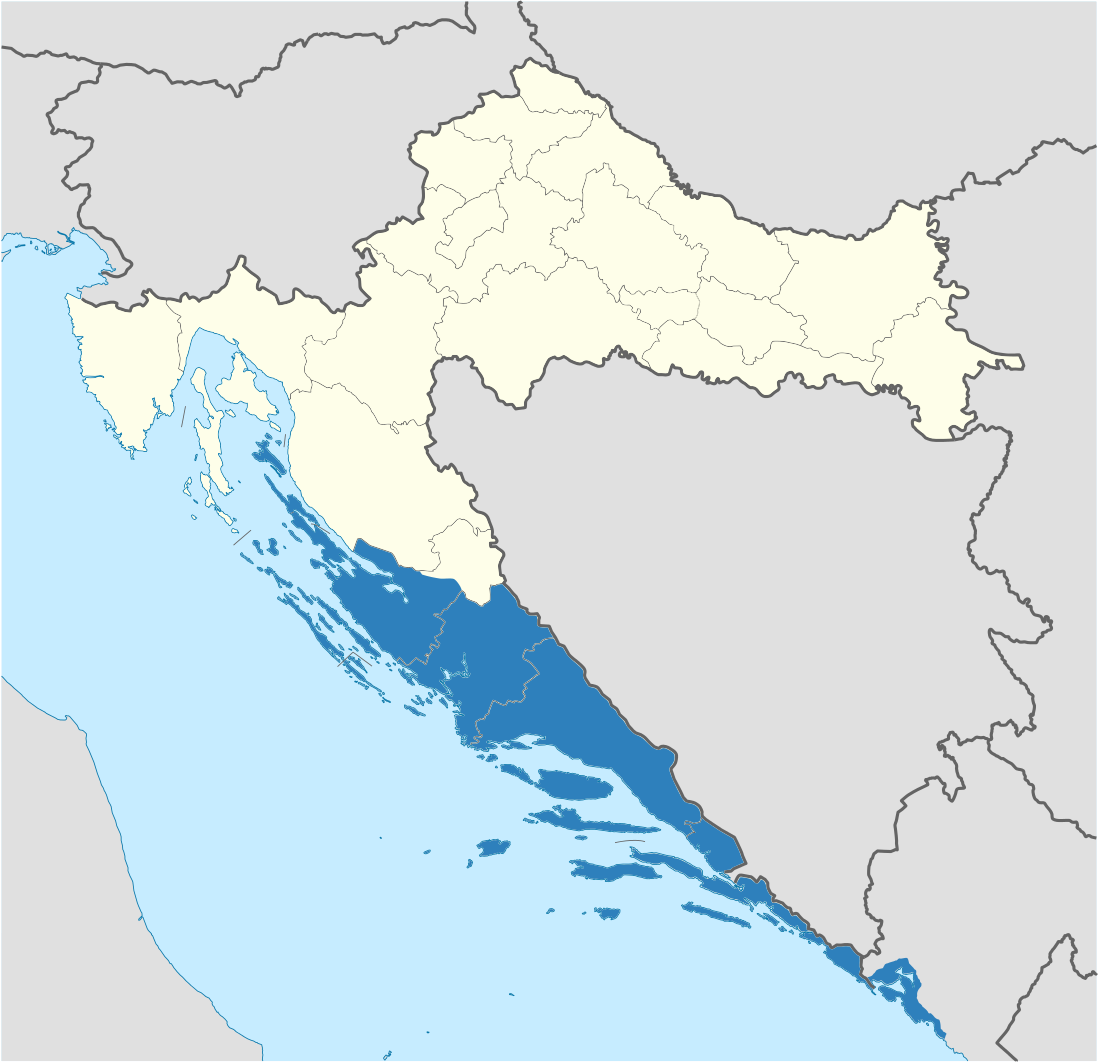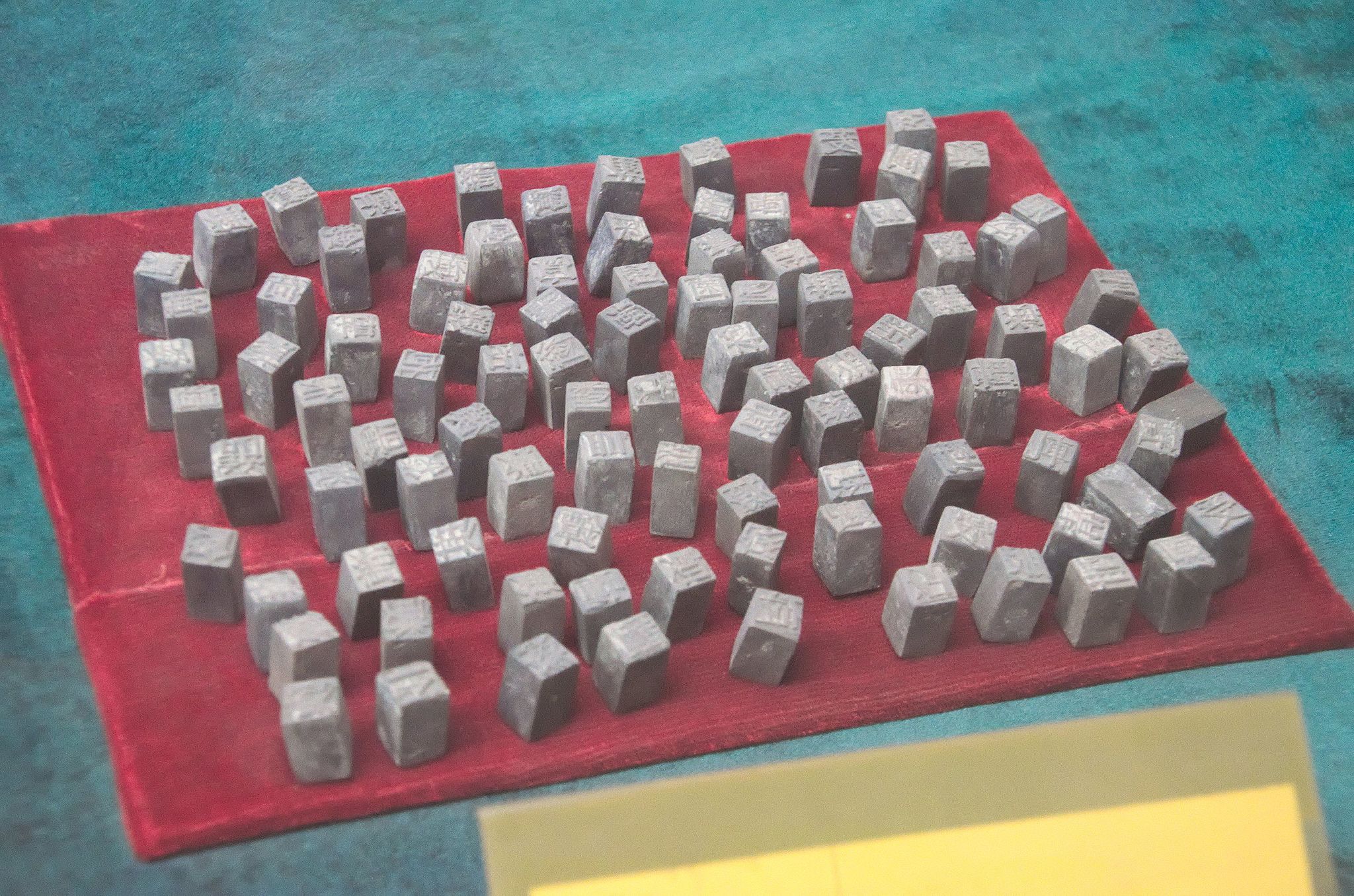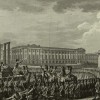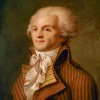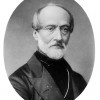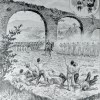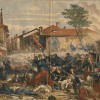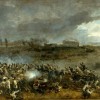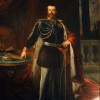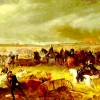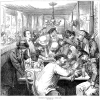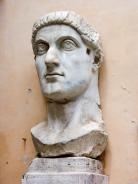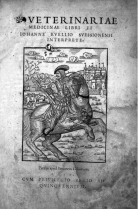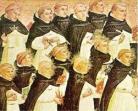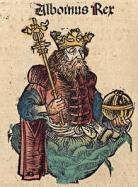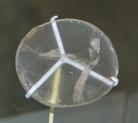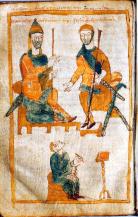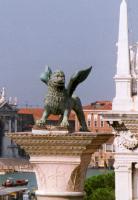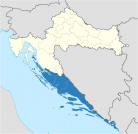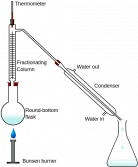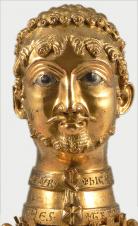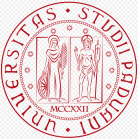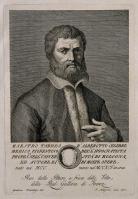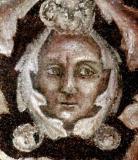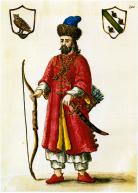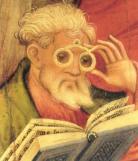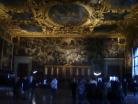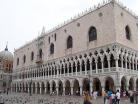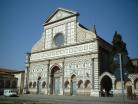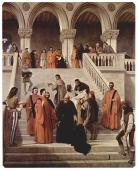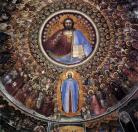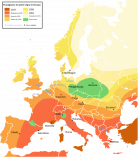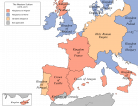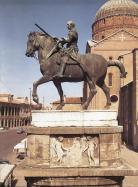in the year 1000, under Doge Pietro II Orseolo, Dalmatia was finally in complete control of the Venetians after many years of battle, tribute-payment, and political maneuvering in response to Dalmatian pirates. This marked the beginning of the Venetian empire. Image: the extent of the Kingdom of Dalmatia (blue), on a map of modern-day Croatia. This file is licensed under the Creative Commons Attribution Share Alike 3.0 Unported license.
Making the Human/ Inventing Venice
Created by Dino Franco Felluga on Fri, 12/30/2016 - 10:56
Part of Group:
This timeline allows students to see important events connected to the transition from Medieval to Renaissance Italy (focussed especially on Venice).
Timeline
Chronological table
|
Date |
Event | Created by | Associated Places | |
|---|---|---|---|---|
| circa. 1 |
De Architectura:De Architectura is a set of 10 books written between 30 and 15 BC by Vitruvius on Roman architecture. They were dedicated to the emperor of the day, Emperor Caesar Augustus. It covers a variety of subjects, including the building materials used in construction, different types of building designs, aqueduct designs, and explanations of how to use and construct machines used in the construction process. It was rediscovered in the 15th century and became a prominent influence in Renaissance architecture, eventually leading to the reintroduction of the classical style into architecture of the day. The photo is by Mark Pellegrini (Own work) [CC BY-SA 2.5 (http://creativecommons.org/licenses/by-sa/2.5)], via Wikimedia Commons. It is free to copy and distribute. |
Teresa Ortyl | ||
| circa. 20 to circa. 90 |
Life of VitruviusThe actual dates are circa 90 BC to 20 BC. Vitruvius was a Roman architect and engineer for the military. He is well known for writing his book, De Architectura. This book, which covers topics from architecture to anatomy, became prevalent during the renaissance. Throughout his military career, he traveled around to places such as Asia, Africa and Greece. These areas, and Greece in particular, would show their influence in his book. This information is from http://www.ancient.eu/Vitruvius/. The image comes from wikimedia commons and is public domain. |
Tim Brunner | ||
| 85 |
Rhetorica Ad HerenniumWritten circa 85BC, this manuscript describes how to deliver an oration, especially persuasive messages. Rhetorica ad Herennium was a gift to Gaius Herennius (hence the ad Herennium portion of the title translated "to Herennius"). Although the author is not decidedly known, the work must have originated from a great Roman political orator like Cicero, who had written another similar text on rhetoric, De Inventione. Works like Martin Luther King, Jr.'s "I Have a Dream" speech and most five-paragraph essays written by high school students follow the format Rhetorica ad Herennium suggests for presenting and supporting a persuasive argument. Rhetorica ad Herennium demonstrates the nature of communication in ancient Rome prior to widespread literacy and print. Orations with a purpose were valued whereas a work like a lyric poem would not be. |
Barbara McAnulty | ||
| 330 |
Emporer Constantine I sets up new capital in Byzantiumin the year 330, Roman Emperor Constantine I set up his new capital in Byzantium after his conversion to Christianity. He was the first Christian Roman emporer. Image: Marble head representing Emperor Constantine the Great, at the Capitoline Museums in Rome, Italy. Permission is granted to copy, distribute and/or modify this document under the terms of the GNU Free Documentation License, Version 1.2. |
Dino Franco Felluga | ||
| 401 |
The HippiatrikaThe Hippiatrika is a compilation of the veterinary writings of several different authors in the 5th and 6th century. An anonymous author compiled these texts in the 10th century during the reign of Emperor Constantine VII Porphyrogenitus. Among these early writers was Apsyrtus, a prominent army officer of the Byzantine era. He left a detailed written record of his diagnostics and taught principles of veterinary medicine to his cavalrymen. Apsyrtus was the first to describe with a degree of accuracy the etiology of disease and infection in the horse. At the point in history at which the Hippiatrika was compiled, horses fared better than man - their treatment was based in more scientific values rather than hope in a rabbit's foot. The text continued to be produced throughout the centuries and spread across the world. It set the stage for science, informing and giving birth to modern medicine. |
Hannah Mylin | ||
| 25 Mar 421 |
Founding of VeniceThe mythical foundation of Venice (during the feast of the Annunciation of the Virgin) is said to have occurred on 25 March 421. 421 is also the legendary date for the foundatin of the church of San Giacomo di Rialto (next to the Rialto bridge in Venice). Image: San Giacomo di Rialto. This file is licensed under the Creative Commons Attribution Share Alike 4.0 International license. |
Dino Franco Felluga | ||
| circa. 500 to circa. 1400 |
Middle Ages Music and the Gregorian Chant:Because of the dominance of the Catholic church during this time period, there was a heavy emphasis on religous music. The Gregorian Chant was the starting form of music for this time period. It consisted of a monophonic style without any harmonies. The melodies were free of tempo and were dictated based on the Latin texts on which they were based. As time progressed towards the end of the Middle Ages, some developments of polyphonic music started to come about, with some compositions successfully integrating two to five different voices together, but not done nearly as smoothly as during the Renaissance. |
Justin Chan | ||
| circa. 568 to circa. 569 |
Alboin, King of the Lombards, invades Northern ItalyAlboin, King of the Lombards, invaded Northern Italy from the year 568 to 569, driving mainland residents once again to the lagoon islands that would become Venice. Unlike the Huns, the Lombards came to stay, thus forcing the lagoon residents to establish a home on the islands. Image: Woodcut vignette of Alboin in the 1493 Nuremberg Chronicle. This work is in the public domain in its country of origin and other countries and areas where the copyright term is the author's life plus 100 years or less. |
Dino Franco Felluga | ||
| 750 |
Discovery and Applications of the First LensDiscovered in 750 BC, Nimrud Lens is considered to be the oldest lens artefact. It is believed to have been used as a magnifying glass to read, to concentrate sunrays to start fires or as a decorative piece. It has a focal length which is roughly 12 centimetres (equal to a 3x magnifying glass). The image is from Wikimedia Commons and is available for public use. |
Sahil Lala | ||
| circa. 774 |
Defeat of Lombard Kingdom by CharlemagneDefeat of Lombard kingdom by Charles I, King of the Franks (more commonly known as Charlemagne) in the year 774. The Franks divided the Lombard kingdom with the Pope at Rome, thus creating the Papal States. Image: Charlemagne (left) and his eldest son, Pepin the Hunchback. Tenth-century copy of a lost original from about 830. This work is in the public domain in its country of origin and other countries and areas where the copyright term is the author's life plus 100 years or less. |
Dino Franco Felluga | ||
| 800 |
Wood Ash as Glass InputBecause soda ash from Egypt was no longer a viable input due to cost and inefficient trade routes, glassmakers in Northern Europe began to utilize wood ash, typically from beech or oak trees, to make glass by 800. Wood ash was later combined with sands to concoct hard, heavy, opaque glasses desirable for cutting and engraving. An important note is that the output glass were not delicate pieces of art desired by a worldwide market as Venetian glass would be centuries later. This glass from wood ash was typically used for practical items, like windows. The photo of a European Beech tree was obtained from Wikipedia. The image is licensed under Creative Commons to share if attributed to Jean-Pol Grandmont. |
Barbara McAnulty | ||
| 828 |
Theft of the relics of Saint Mark from AlexandriaIn 828, the relics of Saint Mark the Evangelist were stolen from Alexandria. In 829, the Greek soldier-saint Theodore is replaced as the patron saint of Venice by the evangelist Saint Mark. At the water entrance to Venice (Saint Mark's Square), there are two pillars. At the top, are both patron saints. Image: The Lion of St Mark on top of a column in the Piazzetta in Venice, seen from the Doges Palace. This file is licensed under the Creative Commons Attribution Share Alike 3.0 Unported license. |
Dino Franco Felluga | ||
| 1000 |
Dalmatia conquered by Venetian empirein the year 1000, under Doge Pietro II Orseolo, Dalmatia was finally in complete control of the Venetians after many years of battle, tribute-payment, and political maneuvering in response to Dalmatian pirates. This marked the beginning of the Venetian empire. Image: the extent of the Kingdom of Dalmatia (blue), on a map of modern-day Croatia. This file is licensed under the Creative Commons Attribution Share Alike 3.0 Unported license. |
Dino Franco Felluga | ||
| 1021 |
Studies on OpticsArab scholar from the medieval ages, Ibn al-Haytham (better known as Alhazen in the west), wrote his seven volume book on optics and other fields of study called the 'Book of Optics.' It disagreed with the then popular extra mission theory of vision, believed by Euclid, which stated that vision was a result of 'particles' leaving the eye and interacting with the object and refuted the theory by providing evidence and experiments to support its counterpart, the intromission theory. The translation of the book from Arabic to Latin is supposed to have laid the foundation for the invention and further development of eyeglasses in Italy in the later years. The image is from Wikimedia Commons and is available for public use. |
Sahil Lala | ||
| circa. 1041 to circa. 1048 |
Invention of Movable Type in ChinaA commoner named Pi Sheng is credited with the invention of the first blocks of movable type in China during the Ch'ing-li period . Each Chinese character was carved onto a small block of moistened clay and then baked to preserve the characters. To print pages, all the characters (all of which required several pieces of type to form) were arranged on an iron plate with a band around the plate to keep the type pieces in place. This image is sourced from Wikimedia Commons and is public domain. |
Laura Titzer | ||
| 1150 to 1200 |
The Beginnings of the Arsenal of VeniceThe Arsenal of Venice, known in Italian as Arsenale di Venezia is a naval shipyard that was the lifeforce of Venice's large merchant navy. Its exact date of orgin is unknown, but the beginning of its life started in the time period from 1150-1200. In 1220 the first two rows of covered water areas called squeri were constructed around the dock of San Marco. At this time in the 13th century, The Arsenal of Venice was called Arsenale Vecchio, or Old Arsenal. The goal of The Arsenal of Venice was to give greater production to the construction of naval vessels, and was proven very essential to the Venetian Empire's success in the Mediterranean, as the bulk of its galleys and large ships were produced there. The Arsenal of Venice is known as one of the most effiecent examples of large manpower production seen in the pre-industrial era. Source of text: The Arsenal of Venice. (n.d.). Retrieved February 06, 2017, from http://arsenalofvenice.weebly.com/ This picture is public domain because its copyright haas expired 100 years plus the author's age. |
Jacob Hussey | ||
| 1167 |
The First Fractional DistillationMedieval alchemist Magister Salernus from the city of Salerno in southern Italy develops an initial conception of the process for the fractional distillation of alcohol. This process features the separation of mixtures by their different boiling points. This process is initally used as a tool for wine distillation, but will go on to be a staple in industrial chemical processes. Image source: Public Domain, https://upload.wikimedia.org/wikipedia/commons/7/70/Fractional_distillat... |
Ryan Gansemer | ||
| 1189 to 1192 |
Third CrusadeThird Crusade, led by Frederick I Barbarossa, Richard I (Lionheart of England), and Philip II of France. On June 1190, Frederick drowns. The crusade is not successful in its main goal of capturing Jerusalem. This failure led to the Fourth Crusade six years later. Image: Bust of Friedrich I., "Barbarossa", gilded bronze, ca. 1160 (image by Montecappio). This file is licensed under the Creative Commons Attribution 3.0 Unported license. |
Dino Franco Felluga | ||
| 1202 to 1204 |
Fourth CrusadeFourth Crusade. The initial goal was the capture of Jerusalem but the invaders ended up instead invading Constantinople, the capital of the Byzantine empire (now Istanbul). Constantinople was seized at the end of of the Fourth Crusade, largely thanks to the political maneuvering of Doge Enrico Dandolo. As a result of the crusade, Venice controls the entire Eastern Adriatic. Venice also buys Crete from Boniface of Montferrat, leader of the crusade, thus ensuring that Venice controls the trade route to Constantinople and Asia Minor. As its part of the looting of Constantinople, Venice brings back the four horses that stand over the entrance of St. Mark’s Basilica. Image: Conquest of Constantinople By The Crusaders In 1204 (15th-century miniature). This work is in the public domain in its country of origin and other countries and areas where the copyright term is the author's life plus 70 years or less. |
Dino Franco Felluga | ||
| 1207 |
Venice extends empire over Greek islandsVenice extends its imperial power by holding sway over the Duchy of the Archipelago, which was created by Marco Sanudo in 1207 (including the Greek islands of the Cyclades, especially Naxos). |
Dino Franco Felluga | ||
| 1221 |
Venice opens up trade with the Mongol EmpireA large factor in Venice's ascension to power in the Medieval Era was due to vast trade connections and agreements with civilizations in the east such as Persia, India, and China, also known as the Silk Road. In 1221, Venice created a trade agreement with the Mongol Empire, the major Asian power of the time. From the East, goods such as silk, cotton, spices, and feathers were brought over in exchange for European goods, such as grain, salt, and porcelain. All of the Eastern goods were brought over through Venetian ports, making Venice a very wealthy and prosperous city. Source: SILK ROAD Dialogue, Diversity & Development. (n.d.). Retrieved February 09, 2017, from http://en.unesco.org/silkroad/content/venice. This image is in the public domain because it came from the site http://www.demis.nl/home/pages/Gallery/examples.htm and was released by the copyright holder. Permission is granted to copy, distribute and/or modify this map since it is based on free of copyright images from: www.demis.nl. |
Jacob Hussey | ||
| 1222 |
University of Padova EstablishedPadova University played a significant role in the development of modern medicine. Where there had been a lack of interest in observation of the natural world due to the dichotomy established between the terrestrial and celestial world, body and soul. Writings of the physical world by Aristotle were rediscovered and interpretation given by the Moem Averroes (1126-1198), which renewed an interest in the natural world by proposing a compromise: it is possible for believers to overcome the contradiction between the Bible and scientific knowledge through double truth. In Bologna and Padova especially, the dissection of the human body emerged as a common practice from this renewed interest. The philosophical focus of studies in Padova created a positive space for anatomical studies to be conducted since Aristotle's writings had been rediscovered and a renewal of interest in the natural world was being cultivated. The first detailed anatomical textbooks and understanding of the human body came out of the studies being conducted at the University of Padova. |
Hannah Mylin | ||
| 1222 |
The University of Padua and anatomic studies in the RenaissanceThe University of Padua was founded in 1222 and has a long tradition and great reputation in anatomic studies. The scientific freedom and political wisdom of the Serenissima Republic of Venice, as well as the flourishing trade and cultural, social, and political life of Venice in the latter half of the 15th century attracted many scientists and students from around Europe to Padua. These scientists and students then contributed to the establishment of Padua as an international center for culture and science. Venice allowed the use of cadavers for anatomical dissection and anatomists at Padua did their own dissections, which was a radical way of teaching at the time, but both contributed immensely to the advancement of anatomy. Sources: https://academic.oup.com/eurheartj/article/30/6/629/642373/Padua-University-The-role-it-has-played-in-the & https://www.ncbi.nlm.nih.gov/pubmed/15458582 Image: Wikimedia Commons (public domain) |
Kate Harris | ||
| 1225 |
Fondaco dei TurchiFondaco dei Turchi was first constructed in 1225 by Giacomo Palmieri and is considered one of the oldest buildings in Venice. The Venetian government took over this palace in 1831 and used it for the Duke of Ferrara, Nicholas II. The space was used for political purposes and then was turned into an Ottoman warehouse in 1621. After a period of disarray, it was resotred in 1858 by Camillo Boito. This information comes from www.venicexplorer.net. This photo is from Wikimedia Commons and is free to share. |
Nathaniel Gollmer | ||
| 1250 |
Taddeo Alderotti Improves the Fractional Distillation ProcessTaddeo Alderotti, a professor of medicine at the University of Bologna, is credited with developing the fractional distillation, giving him a high reputation both then and now. At the time, this process was mostly used for the distillation of fermented products with high alcohol content, such as wine, but today this process is used in the oil and gas industry and in the chemical synthesis industry. Image Source: Public Domain, https://upload.wikimedia.org/wikipedia/commons/e/e8/Florentinus_Thaddaeu... |
Ryan Gansemer | ||
| 1252 |
FlorinThe florin (Italian coin) was created in 1252 and replaced the much less valuable silver coins that dated back to the days of Charlemagne. The florin was unique because it was the first gold coin of Europe struck in sufficient quantities to actually play a significant commercial role since the 7th century. The florin quickly became the dominant trade coin in Western Europe because of the fact that many Florentine banks were international entities that had branches all across Europe. The widespread impact of the florin is seen by the fact that in the 14th century, over 100 European states and their coin-issuing authorities made their own copies of the florin. |
Mara Kossoff | ||
| 1255 to 1380 |
Wars with GenoaWars with Genoa. This is the time period when the two great thalassocracies of the period compete for control of the Mediterranean and of trade routes to the East. The first two Genoese Wars (1255-1270, 1294-9) produced naval victories for each side in an almost random pattern. On balance, the first war favored the Venetians and the second the Genoese. Fifty years of relative peace ensued, the belligerants heavily occupied by other challenges, including awesome onslaughts of plague. The Third Genoese War (1351-5) began well for the Venetians but ended badly. Control of the Genoa government, however, had passed to the Visconti family of Milan, and Venice was able to negotiate a better peace treaty than its military posture would have suggested. From one point of view the Fourth Genoese War (1378-81), called the War of Chioggia, can be viewed as a defeat for the Venetians, but Venice's dramatic and climactic victory at Chioggia, 1379-80, pulled defeat from the jaws of complete disaster. (See a Virtual History of Venice for more.) Image: The Lion of Saint Mark (By Tonchino - Extracted from Flag of Most Serene Republic of Venice.svg, Public Domain). |
Dino Franco Felluga | ||
| circa. 1266 to circa. 1337 |
Life of GiottoGiotto di Bondone was an Italian painter and architect from Florence, Italy. Giotto's masterwork is the decoration of the Scrovegni Chapel in Padua, also known as the Arena Chapel, completed around 1305. Image: Possible image of Giotto: detail of decoration in the Peruzzi Chapel, Church of Santa Croce, Florence, Italy. This detail has been digitally restored. This work is in the public domain in its country of origin and other countries and areas where the copyright term is the author's life plus 100 years or less. |
Dino Franco Felluga | ||
| 1266 to 1271 |
Marco Polo and the EastIn 1266, Marco Polo’s father and uncle meet Kublai Khan in Dadu (present day Beijing, China). Kublai Khan asks them to deliver a letter to the Pope and requests that they return with 100 Christians acquainted with the Seven Arts (grammar, rhetoric, logic, geometry, arithmetic, music and astronomy) plus oil of the lamp in Jerusalem. In 1271, Marco Polo embarks with his father and uncle to visit Kublai Khan, finally arriving there around 1275 delivering the sacred oil from Jerusalem and letters from the Pope. Image: Marco Polo in Tartar costume (18th century; image by Grevembrock - Scanné de Coureurs des mers, Poivre d'Arvor., Public Domain). |
Dino Franco Felluga | ||
| Nov 1284 |
The Guild of Crystal WorkersThe art of making eyeglasses was perfected by the craftsmen in the island of Murano in Venice. These craftsmen came to be known as the Cristallieri. They used quartz or rock crystals as the main material for making these glasses until the discovery of ordinary glass (Cristallum). Very soon craftsmen guilds were created in Venice which laid out certain regulations for making and selling glasses made from Cristallum. The new rules prohibited Cristallieri from selling these ordinary glass products under the guise of exotic crystals. The organization also adopted a term for these “discs for the eyes” by calling them "vetri da occhi". |
Sahil Lala | ||
| circa. 1286 |
Invention of the EyeglassesThe first pair of eyeglasses is invented in Italy. The earliest eyeglasses design was often balanced on the nose or held in front of eyes. The design used principles from Alhazen's Book of Optics, after its translation from Arabic into Latin in the 12th century. Within two decades of their invention, Venice had created guild regulations for the creation and sale of eyeglasses in order to manage the product. Eyeglasses instantly popular, and became more popular after the invention of the printing press in 1452. Image is the "The Glasses of Apostle" by Conrad von Soest and is from Wikimedia. |
Catriona White | ||
| circa. 1291 |
Costs and Benefits of Making GlassVenetians realized the value of their glassmakers, who were forced to be isolated on the Murano Islands in 1291 to prevent fire hazards from destroying Venetian neighborhoods and to reduce communication with other people. By the end of 1200s, glassmakers were not allowed to emigrate from the island so that their highly-sought-after talents could not bring fame and fortune to another region. In return, glassmakers were bestowed with "burgher" status--a much higher class than any other tradesman. The photo is from Google Maps, which has Copyright over the map data, but the users may "publicly display Content with proper attribution online, in video, and in print." Source: How Glass Changed the World by Rasmussen |
Barbara McAnulty | ||
| 1297 |
The Serrata (Closing of the Great Council)In 1297, establishment of Venice’s republican regime. In the act known as the Serrata (Closing of the Great Council), membership in the city’s ruling class was limited to a select set of nearly two hundred families. Image: Chamber of the Great Council (picture by Sailko and distributed under the terms of the GNU Free Documentation License. |
Dino Franco Felluga | ||
| circa. 1300 |
Contributions of SpinaAlthough not the original inventor of the eyeglasses, Friar Alessandro Della Spina is often credited for their invention. The Ancient Chronicle of the Dominican Monastery of St. Catherine in Pisa states: "Eyeglasses, having first been made by someone else, who was unwilling to share them, he [Spina] made them and shared them with everyone with a cheerful and willing heart." Spina is believed to be a liaison who spread this knowledge to the masses after witnessing the handiwork of the original inventor, who wanted to keep this invention a secret. |
Sahil Lala | ||
| circa. 1301 to circa. 1450 |
Construction of the Doge's Palace:The Doge's Palace was built upon the site of an old fort after the Venice hierarchy decided to build a new palace. It was designed by Filippo Calendario in Venetian Gothic style. There were two phases to its construction- the eastern wing, which was built between 1301-1340, and the western wing, which took 110 years to build. This was due to designer Filippo Calendario's execution in 1355, which hindered progress on the western wing. The photo is by MarkusMark (Own work) [CC BY-SA 3.0 (http://creativecommons.org/licenses/by-sa/3.0)], via Wikimedia Commons. It is free to copy and redistribute. |
Teresa Ortyl | ||
| 23 Feb 1306 |
Giordanos' SermonIn a sermon delivered by the Dominican friar Giordano da Pisa, in the church of Santa Maria Novella of Florence, he celebrated the genius of mankind by stating that (translated), "It is not yet twenty years since there was found the art of making eyeglasses, which make for good vision... And it is so short a time that this new art, never before extant, was discovered. ... I saw the one who first discovered and practiced it, and I talked to him." This preaching was of significant importance as it highlights the fact that the art of making eyeglasses was a gradual process and had existed for a while, but this knowledge had not been widely distributed for a long time. The image is from Wikimedia Commons and is available for public use. |
Sahil Lala | ||
| 10 Jul 1310 |
Creation of the Council of TenOn 10 July 1310, creation of the Council of Ten in response to the revolt against the Doge led by Bajamonte Tiepolo. The Council of Ten was composed of ten members elected to a one-year term by the Great Council. Members could not be elected for two successive terms. Image: The death of Doge Marin Faliero by Francesco Hayez. This work is in the public domain in its country of origin and other countries and areas where the copyright term is the author's life plus 100 years or less. |
Dino Franco Felluga | ||
| 1312 |
English Chapel Royal:With records dating back to 1312, the Chapel Royal is a group of singers that are appointed to sing for the country's reigning sovereign. They would travel wherever the monarch was living at the time, and was originally created for religious, or spiritual purposes. It is said that the chapel acheived its greatest height during the reign of Elizabeth I because of William Byrd and Thomas Tallis both being members. Eventually, the name came to encompass the building that they used. It is still used today. Image source: Wikipedia |
Justin Chan | ||
| circa. 1320 to circa. 1391 |
Life of Guisto de’ MenabuoiLife of Guisto de’ Menabuoi, an Italian painter of the early Renaissance: c. 1320-1391. Image: Detail of Paradise, Dome of the Padua Baptistry, by Giusto de' Menabuoi (Web Gallery of Art, public domain). |
Dino Franco Felluga | ||
| 1320 |
Expanding The Arsenal of VeniceIn 1320, the “Nuovo Arsenale” was added on to the Arsenal of Venice. The Nuovo Arsenale digresses from the Byzantine design of the former “Arsenale Vecchio” as well as provides much more room for producing and maintaining the growing merchant and militant navy. The Nuovo Arsenale helped the Venetian Empire build more ships at a faster pace than before. This picture is okay to use because this file is licensed under the Creative Commons Attribution-Share Alike 3.0 Unported license. Source: http://www.aviewoncities.com/venice/arsenale.htm. |
Jacob Hussey | ||
| 1328 to 1329 |
War with the Della Scala empireThe Della Scala family, the rulers of Verona, capture Padua and Treviso, thus bringing the Della Scala empire to the shores of Venice itself, forcing Venice to attack in October 1336, leading to the capture of Padua and a military alliance with Milan, Manua, Este and Florence. The resulting peace treaty with the Della Scala family also gave Venice Treviso. Venice placed her new mainland territories under the rule of the Carreras of Padua who helped Venice defeat the Della Scala family; however, the Carreras then sought to get out from under Venetian control. |
Dino Franco Felluga | ||
| 1347 |
Bubonic Plague Hits EuropeThe Bubonic Plague began is said to have began in 1347. As medicine was not advanced, over 25 million people died. Although the bubonic plague is found mostly in small rodents and is transmitted to humans through fleas. Once caught, the plague is very contagious and killed quickly. Symptoms include fever, chills, weakness, and headache. This information is from the CDC and www.themiddleages.net. This photo is from Wikimedia Commons and is free to share. |
Nathaniel Gollmer | ||
| 1348 |
1348 Black Death reduced the Venetian population by one halfThe Black Death devastated Venice in 1348, reducing its population by one half. Plague occurred in Venice 22 times between 1361 and 1528. Image: The Dance of Death by Michael Wolgemut (1493) from the German printed edition, folio CCLXI recto from Hartman Schedel's Chronicle of the World (Nuremberg, 1493) thought to be created by Michael Wolgemut (b. 1434, Nürnberg, d. 1519, Nürnberg). This work is in the public domain in its country of origin and other countries and areas where the copyright term is the author's life plus 100 years or less.
|
Dino Franco Felluga | ||
| 1352 |
Portrait of Hugh of Saint-CherIn order to validate Dominican intellect, Tommaso da Modena was commissioned to paint a fresco cycle of 40 different Dominican scholars. This portrait of Saint Cher is one of the earliest depictions of a person using spectacles. The image is from Wikimedia Commons and is available for public use. |
Sahil Lala | ||
| 1366 |
Syria-Venice Trade Route EstablishedIn 1366, the governments of Syria and Venice established a regular schedule for imported Levantine soda ash to arrive in Venice by cargo ship after those ships had delivered cotton to Syria. High-quality ash was a key input for high-quality glass. In the year 1395, 350 tons of ash were being imported. One hundred years later, 1750 tons arrived in Venice annually thus demonstrating the rise of the Venetian glass market throughout the 15th century. |
Barbara McAnulty | ||
| circa. 1378 to circa. 1418 |
Western Schism (Papal Schism)In 1377, under the leadership of Pope Gregory XI, the Western Roman Church saw the return of the papacy to Rome. This transition marked a temporary end to the reign of the papacy in Avignon, where materialism and corruption had taken root, ostracizing many who practiced Western Christianity. After the death of Gregory XI, political tensions rose as the election of a Neapolitan pope (Urban VI) caused conflict that resulted in the election of a series of antipopes, who served as rival claimants to the papacy. Conflict among the leaders of the Church escalated rapidly, creating political divides that forced secular European leaders to align themselves with either the Roman or Avignonese papal claimant. Rivalries among Catholic factions throughout Western Europe preserved the Western Schism for several decades, until the Council of Constance resolved the conflict in 1418. (Image Source: Unknown [CC BY-SA 3.0 or GFDL], via Wikimedia Commons, https://commons.wikimedia.org/w/index.php?curid=11502296) |
Andrew Natoli | ||
| 1378 to 1381 |
Fourth Genoese War (War of Chiogga)Fourth Genoese War (also termed the War of Chiogga). The Carraras of Padua sided with the Genoans. Despite being surrounded and near defeat, Venice managed to defeat the Genoese fleet at Chiogga. Exhausted by her wars, Venice elected to cede Treviso and her other mainland possessions to the Duke of Austria, whom she deemed to be less of a long-term threat than the Carraras. Venice retreats to her island fortress. |
Dino Franco Felluga | ||
| 1382 to 1388 |
Treviso under seigeFrom 1382-88, the Carraras placed Treviso under seige and offered Austrians 100,000 ducats for Treviso and the other former mainland possessions of Venice; however, in 1388 Venice arranged an alliance with Milan. Milanese forces captured Padua and returned Treviso to permanent Venetian control, retaining Padua and its western possessions for itself. |
Dino Franco Felluga | ||
| 1386 to 1466 |
Life of DonatelloLife of Donatello (Donato di Niccolò di Betto Bardi), an early Renaissance sculptor from Florence: c. 1386-1466. Image: Donatello's equestrian statue of Gattamelata at Padua, the first example of such a monument since ancient times (public domain). |
Dino Franco Felluga | ||
| 1390 to 1404 |
War for control of PaduaVenice sided with the Carraras again (along with Florence and Bologna) to oust Milan from Padua. Once the Carraras were back in power in Padua, they attacked Milan-controlled Vicenza. The Milanese arranged for Venice to attack Padua to stop the Carraran western advance. Venetians captured Padua in November 1404; they executed Francesco Carrara and his son Jacopo. Venetians now controled Padua, Vicenza and Verona, along with Treviso. |
Dino Franco Felluga |

